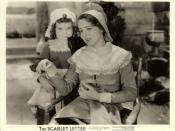John Mendez
Mrs. Ragle
AP English 3
January 2003
The Scarlet Letter
In Nathaniel Hawthorne's The Scarlet Letter, the author uses three scaffold scenes to identify the development of Hester Prynne. The story takes place in the 1600s in a small Puritan village in Boston. Hester on the scaffold is a symbol of her forced isolation; for her rejection from society; and for the uselessness of her punishment. In the first scene, Hawthorne uses the scaffold to explain how Hester cannot believe that the "A" and the baby are real. In the second scaffold scene, Hawthorne tries to show that Hester has fully asked forgiveness for her sin, though this is not true. In the final scaffold scene, Hester does not yet fully ask forgiveness for her sin because her love for
Dimmesdale is still strong. Through Hester, Hawthorne is trying to say that it is difficult for Hester to ask forgiveness for the sin of adultery.
In the first scaffold scene, the author writes "Could it be true? She clutched the child so fiercely to her breast, that it sent forth a cry; she turned her eyes downward at the scarlet letter, and even touched it with her finger, to assure herself that the infant and shame were real. Yes!-these were her realities-all else had vanished" (41), Hester is just beginning to deal with the shame of her sin. It is obvious that she has not yet come to with her actions. She is in a complete state of shock, and it seems as if she is trying to find a way to forget about her sins. What is also learned from these words is that Hester
is a proud woman. They symbolize Hester's pride because even though her life is not getting better, and she faces...


